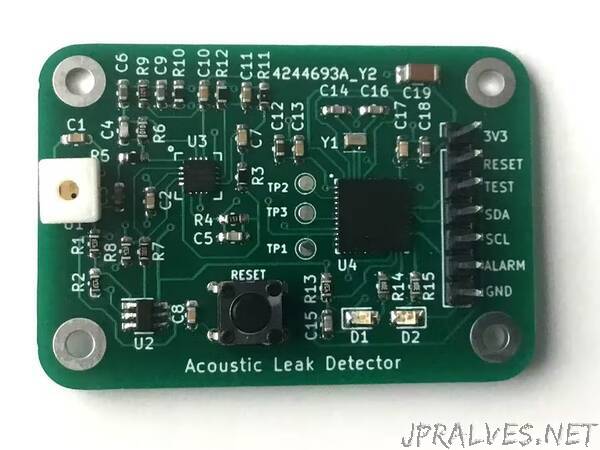
“Battery powered, stand-off acoustic water leak detection
Story
The AquaPing is an ultra-low power smart sensor that provides stand-off water leak detection — even for leaks behind walls. No contact with plumbing is needed. All signal processing and analysis occurs at the edge, so no audio is streamed to the cloud. Eavesdropping is impossible.
When pressurized water escapes from a seam, crack, or loose fitting on plumbing, broadband high frequency acoustics are emitted. These signals can travel 10m or more in free-space and be detected by a remote sensor. This suggests a stand-off method for water leak detection that is substantially different compared to conventional contact moisture sensors and various types of smart flow meters installed on or inside of plumbing lines.
Acoustic leak detection combines the principles of glass breakage and smoke detectors. Glass breakage occurs on a timescale of a few seconds or less, requiring continuous data acquisition at rates approaching 1 kHz or more. Almost all plumbing leaks are persistent, which allows for sub-Hz sampling rates and exceptional battery life.
Glass breakage has the advantage of being generally louder than the ambient environment so that detector sensitivity is not an issue. Small water leaks, especially when when separated from the sensor by acoustic barriers such as walls, are likely to be at or below the environmental background. Much higher sensitivity and noise mitigation are essential. This is addressed by electronic and mechanical filtering plus judicious use of statistical analysis.
Acoustic sensing can be used to complement standard leak detection techniques and will be especially useful when monitoring large areas. Anticipated use cases are in smart homes and buildings, security systems, irrigation, dental and medical offices, critical plumbing installations, insurance loss mitigation, and water conservation.
This acoustic approach to water leak detection works well but is not capable of identifying all possible water issues. For example, it will not respond to leaking roofs or melting ice. The nature of the pressurized orifice is also important. A smooth hole drilled into a pipe will produce a Laminar flow jet that emits a much weaker acoustic signal compared to a jagged crack or loose fitting at the same backing pressure.”
